Nutrition can play a role as the cause of a disease (e.g. deficiencies, foodborne illnesses), but it can also cure diseases (e.g. struvite dissolution), or support in management (e.g. osteoarthritis) or prevention (e.g. periodontal disease) of diseases (Baldwin et al, 2010; Freeman et al, 2011). Nutrition is a very important topic for pet owners. Pet owners like to give food and treats to their companion animals and they want to be assured by their veterinary team that they are giving the right foods and treats. Providing food and treats strengthens the human–animal bound, and it is rewarding to both pets and owners (White et al, 2016). Treats are often used in training, as food is a very strong motivator for pets. A common pitfall is that pet owners over-treat animals, which might have opposite the effects; withholding foods or treats can result in severe withdrawal symptoms such as begging or aggressive behaviour (Pretlow and Corbee, 2016). Overweightness is therefore the most common nutrition-related disease in pets, which is difficult to treat (German, 2006). Therefore, at Utrecht University Companion Animal Clinic, a pet obesity clinic was opened. The pet obesity clinic was set up according to the example at Liverpool University, and was run by a veterinarian (nutrition resident Ronald Jan Corbee) and a veterinary nurse (Inge van Duiven). The other veterinarians and veterinary nurses were very happy with this new service and started referring many cases of over-weight dogs and cats that were referred primarily for other illnesses. In parallel to the obesity clinic, the nutrition service was started. At first, most cases were dealt with by the nutrition resident, who was responsible for nutritional assessment, nutritional recommendation, and follow up, as he needed to have a large case load for his residency. But the veterinary nurse gradually took over most of these tasks, as she learned quickly through being present at the nutrition consultations, through company training events, and by attending post-graduate courses in nutrition. Later on, a veterinary nurse, who is also human dietician (Rilana van de Lande), was hired as the other veterinary nurse missed the contact with the animals and returned to her job as veterinary nurse at the teaching hospital. The veterinary nurses have really advanced the nutrition service and made it very rewarding (both in terms of client and staff satisfaction, and profitability).
Setting up the nurse-led nutrition service in private practice
Within private practice a dedicated veterinary nurse, who is well trained, could also set up a nutrition service. The Academy of Veterinary Nutrition Technicians has a board certified training programme for veterinary nurses (www.nutritiontechs.com). Apart from nutritional training, the veterinary nurse should have excellent communication skills (Baldwin et al, 2010). Running the nutrition service could be a part-time job, as the case load is dependent on referrals by the veterinarian(s), but the nurse should get sufficient time for nutrition consultations and nutrition training. A dedicated veterinarian with extra training in nutrition could be a good alternative as a specialist, as it is often not possible to have a board certified nutritionist in the clinic. The veterinary team should be aware of the existence of a nutrition speciality service, and whom to refer to in their own country if necessary. Another option is that practices might work together in setting up a nutrition service. There might be a working relationship between practices that are in reasonable proximity of each other for emergency shifts at weekends and evening/nights. The dedicated veterinary nurse might have one steady work place (practice) where a wide variety of stock is stored. But the veterinary nurse's salary could be paid by several practices and therefore the veterinary nurse would be available for the patients of all committed practices.
It is important that all staff members are supporting the nutrition service, and that they acknowledge the importance of nutrition in veterinary care. This can be enhanced by involving the dedicated veterinary nurse in (multidisciplinary) patient rounds, and in-house staff education programmes. There should be a dedicated area for the nutrition service, so the veterinary nurse is able to chat with a client without being disturbed, have a display of bags, treats, feeding toys, anatomy models, and books. This could also be a consultation room, which can also be used for other consultations, but with the necessary tools available. An example of the Utrecht University nurseled nutrition service is shown in Figure 1. There should be weighing scales for cats and dogs (at least one of each per practice, which is easily available for clients and staff). Body condition scoring charts (Figure 2) and muscle condition scoring charts (Figure 3) should be available in every consultation room (Freeman et al, 2011). For rabbits, guinea pigs, and birds size-o-meters (https://www.pfma.org.uk/pet-size-o-meter) can be used. It is important that veterinarians and veterinary nurses within the team give the same information to the client. A body condition score under 4 or over 5 on a 9 point scale should always be discussed with the pet owner, as an improper body condition score decreases life expectancy (Kealy et al, 2002). It is also a good tool for pet owners during follow up, so let the pet owner score their own pet first, then the veterinary nurse can perform their scoring, and discrepancies (if applicable) can be discussed with the client. Growth charts are helpful to give good nutritional recommendations for growing puppies and kittens, which can be done in collaboration with the veterinary nurse who is responsible for the puppy/kitten consultation service (Salt et al, 2017). There should be a different place to store larger bags of food, trays of canned food, and freezers for storage of raw food diets. Beware of too much branding, as the primary task of the veterinary healthcare team is to provide information and not to drive pet food sales. Do not be afraid to charge the client for the nutrition service, especially when they are not buying the food at the clinic. If raw pet foods are recommended and sold, make sure that health risks and zoonotic potential (van Bree et al, 2018) are discussed. In several veterinary hospitals, there are raw food policies implying that raw foods are not administered to pets in the clinic because of the increased risks of foodborne illnesses in hospitalised animals (AVMA, 2012).
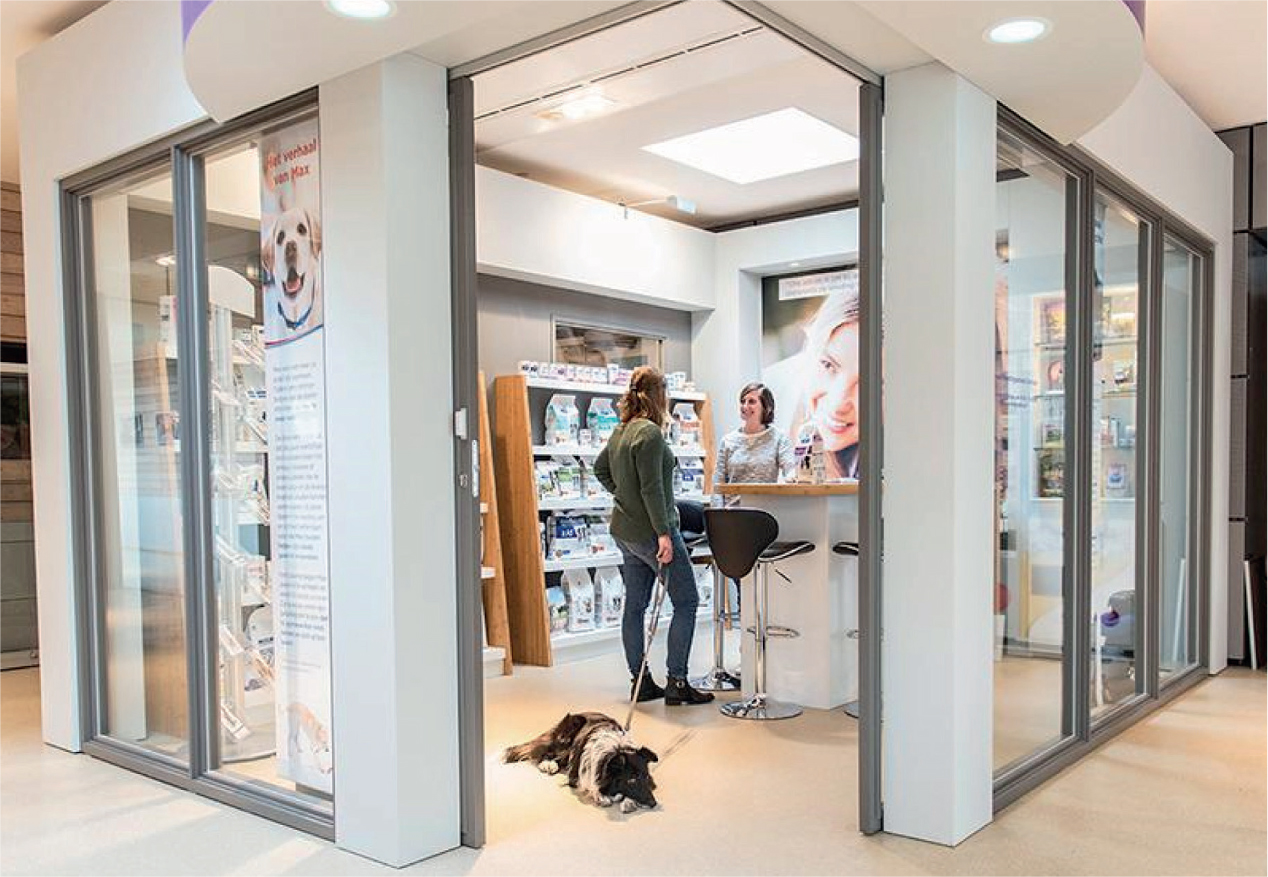
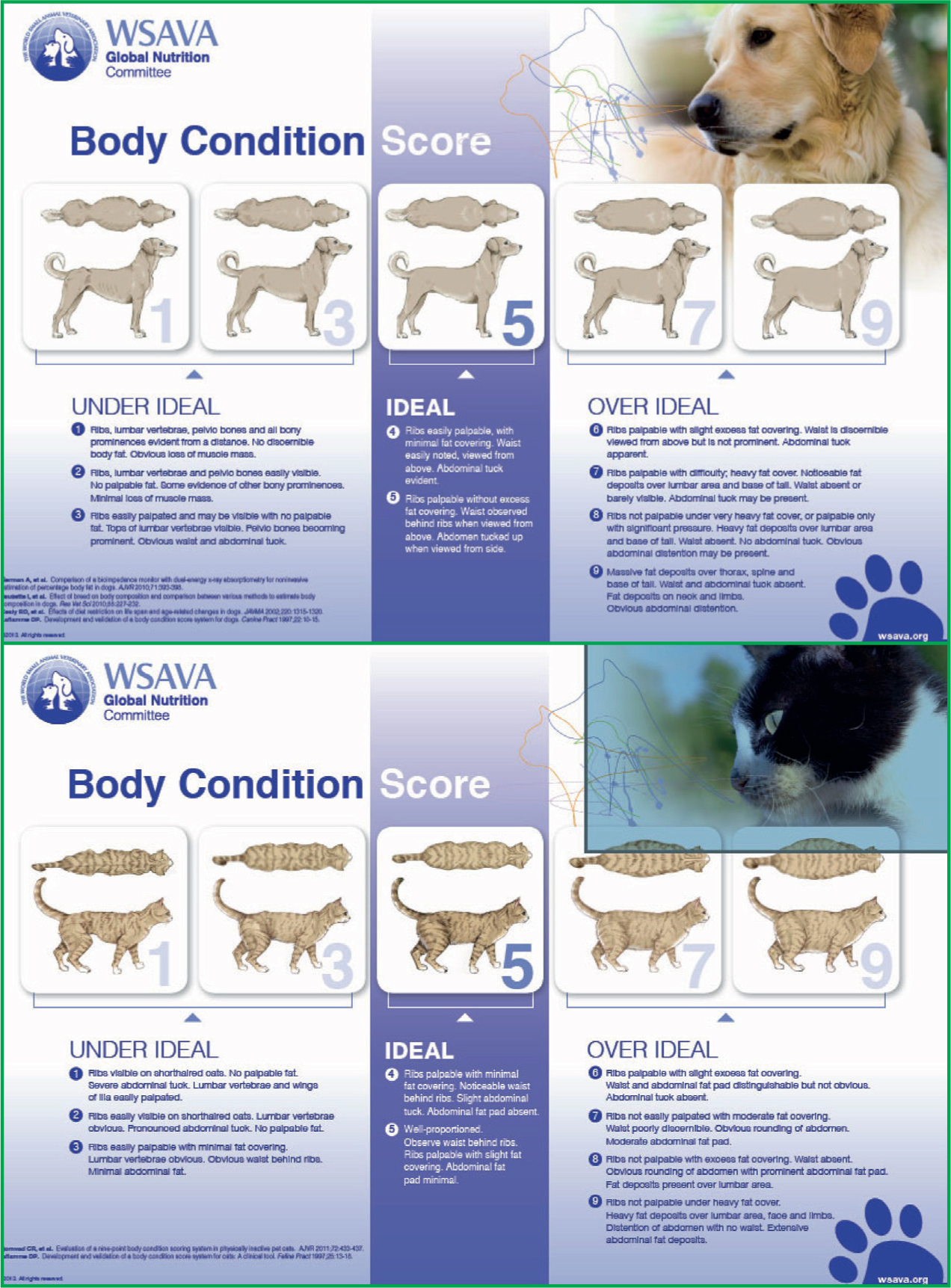
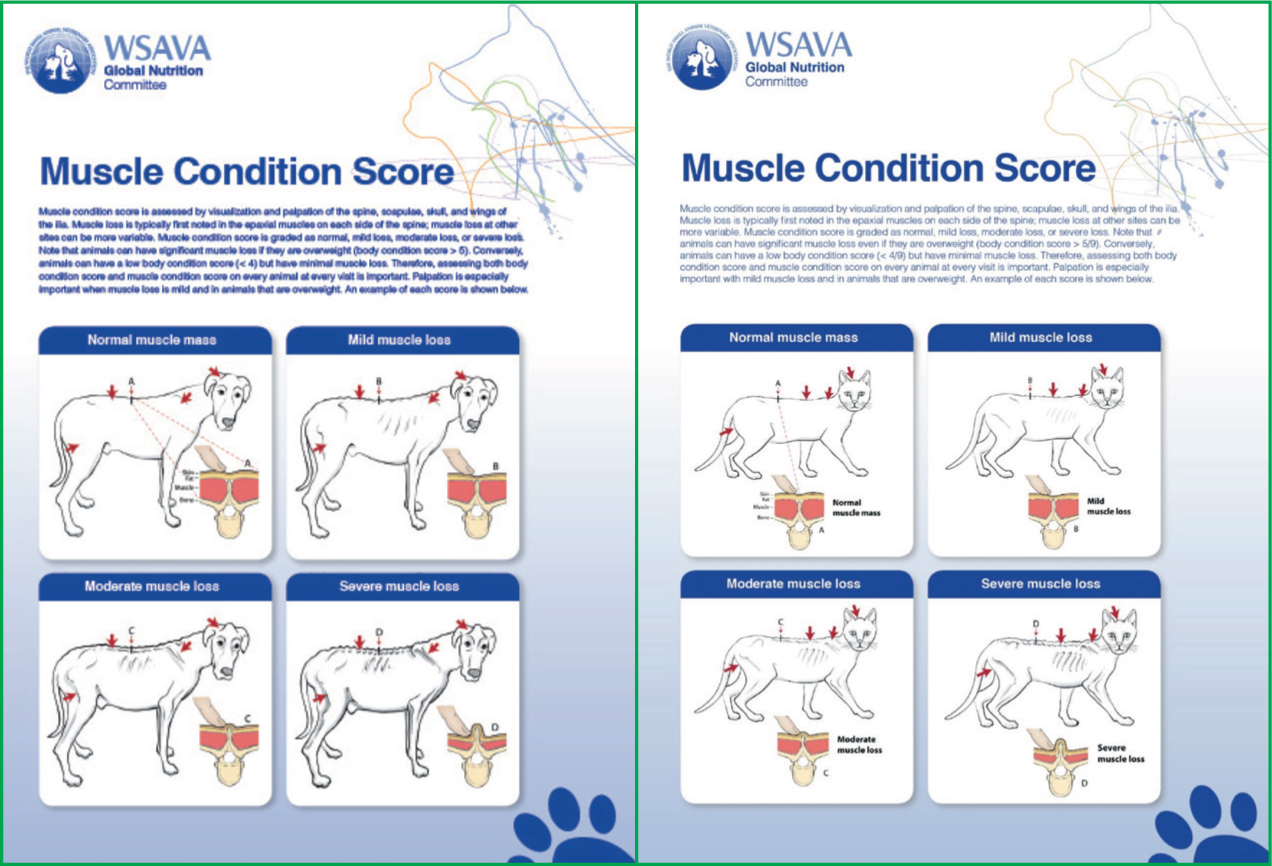
Nutritional assessment
The first step in every consultation is to do nutritional assessment. A screening evaluation is performed on every animal. A screening evaluation consists of patient description, weighing, body condition scoring, muscle condition scoring, patient and diet history, which can all be performed by the veterinary nurse, followed by physical examination by the veterinarian. If nutritional risk factors are present (Figure 4), an extended evaluation should be performed, taking into account animal factors (e.g. food intake, medical conditions), diet factors (e.g. calculations on nutrients, feeding amount), and feeding management and environmental factors (e.g. multiple pet household, activity, environmental stressors). To be able to check if the current diet is meeting the specific nutritional requirements for the age and species of animal, the Fédération Européenne De l'Industrie des aliments pour Animaux Familiers (FEDIAF) or European Pet Food Industry Federation Nutritional Guidelines can be used (European Pet Food Industry Federation, n.d.). When evaluating commercial diets, representatives of the brand can be/should be of assistance. Pick brands that will provide basic education to veterinary nurses and that are available by phone if veterinary nurses are in need of assistance. When evaluating homemade diets, food databases can be used (https://ndb.nal.usda.gov/ndb/). If veterinary nurses are unsure or do not have the skills to evaluate these diets, they should know who to refer to.
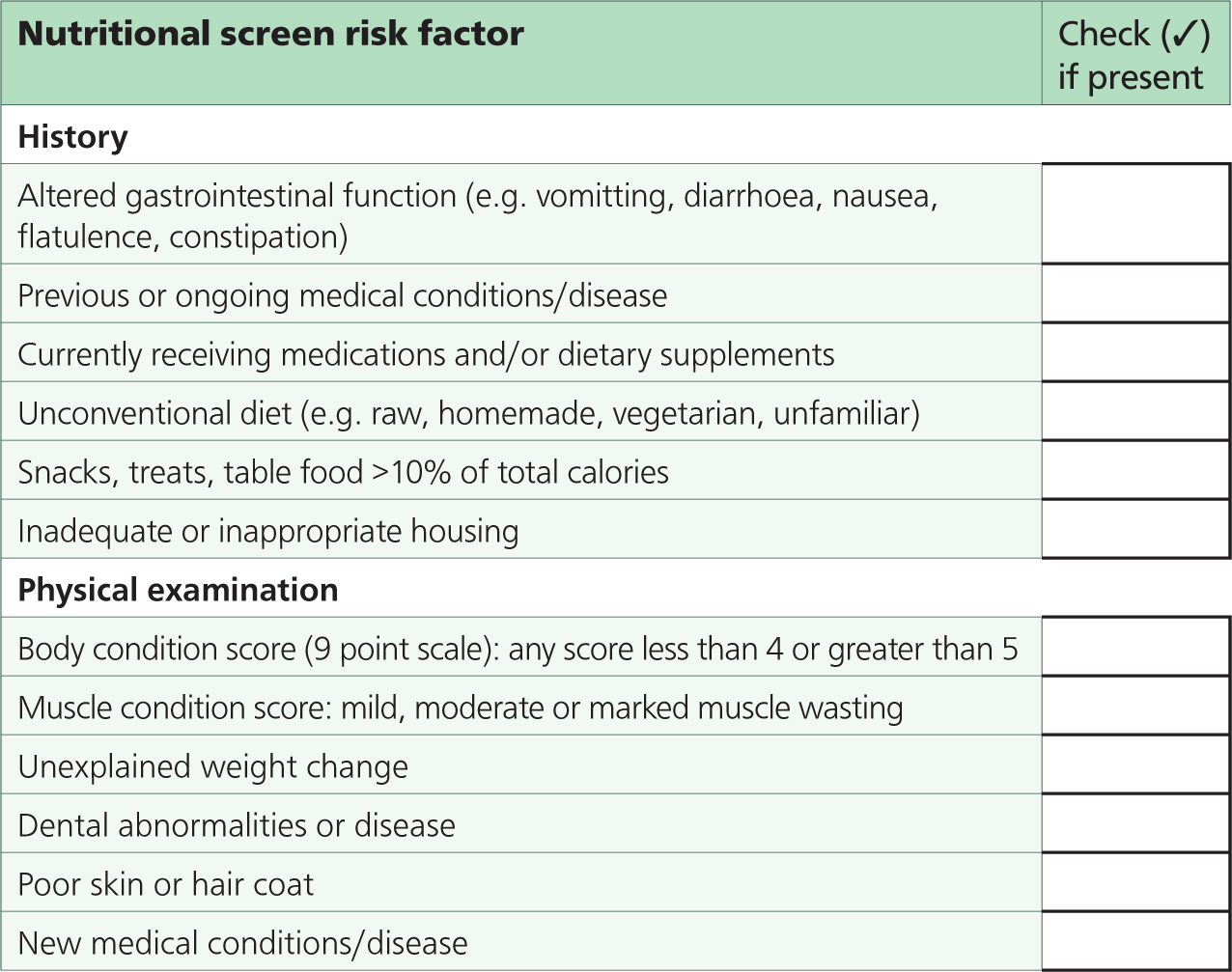
Nutritional recommendation
Nutritional recommendation consists of type of food (nutritional composition), and diet form (e.g. kibble, canned), feeding amount, feeding management and follow up. The entire team should give the same information. Engage the client in decision making, and ask the client about their concerns and expectations. Teach the client how to monitor nutrition and health status. Set specific, measurable, achievable, relevant, and time-bound (SMART) goals, and be sure that recommendations are very specific to prevent own interpretations by pet owners.
Follow up
After each nutritional recommendation a first follow-up appointment should be scheduled after 2 weeks to discuss owner satisfaction (does the pet like the food, any other concerns), weight of the animal, and (if applicable) clinical effects. Compliance can only be achieved when the nutritional recommendation is well accepted by the client and followed through (CRAFT). The pet owner should be contacted by the veterinary nurse 1 or 2 days after the visit, to ensure they understood the nutritional recommendation and to check if the animal likes the new diet (if applicable). Having a follow-up appointment ensures the pet owner is aware that the nutritional recommendation is very important according to the veterinary team, and it is therefore essential for increasing compliance.
Who does what
Front desk staff can hand out a nutrition history form (Figure 5), weigh the animal, and write down the nutrition history in the patient file when the client arrives at the clinic. The veterinary nurse of the nutrition service can do a nutritional assessment. The veterinarian will do the consultation, in which the veterinary nurse can assist by asking nutrition-related questions and initiate discussion on nutritional recommendation. It is important that the veterinary nurse and the veterinarian are reinforcing each other's messages to the client. Together, the veterinarian, the veterinary nurse, and the client should agree on a nutritional recommendation and follow-up plan. The veterinary nurse should explain monitoring tools and schedule any follow-up appointment(s). The front desk staff can ask if the client has any questions, dispense the food, and reinforce the nutritional recommendation. The dedicated veterinary nurse and the dedicated veterinarian are responsible for delivering team training sessions, to keep the entire team motivated and explain the benefit of nutrition in health and disease. Good communication is key, as well as making accurate notes on patient records, which can be viewed by the entire team. This also prevents repeated discussions and questions regarding nutritional assessment and recommendations.
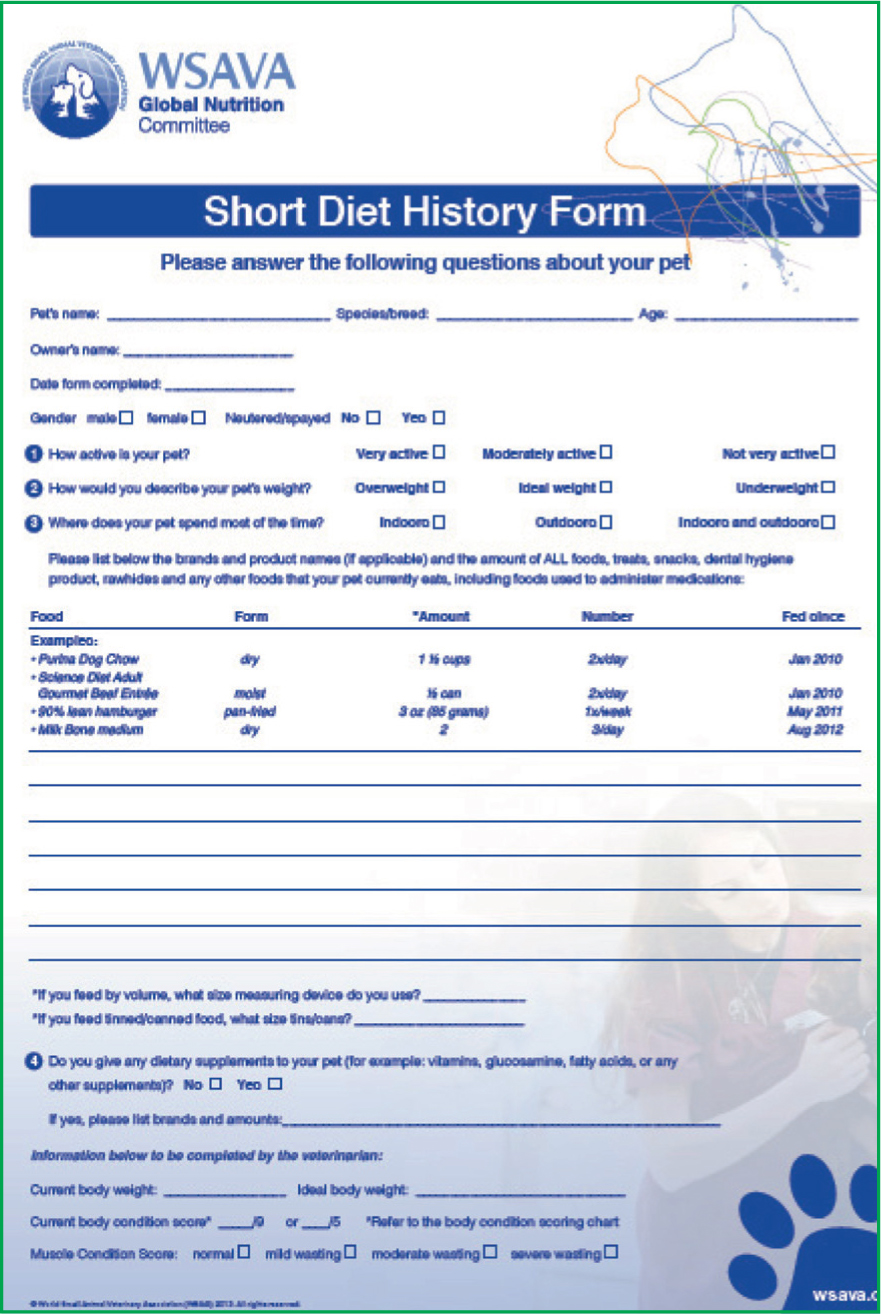
Hospitalised patients
The veterinary nurse of the nutrition service can also assist in providing nutritional assessment, nutritional recommendation, and a follow-up plan for hospitalised patients. It is important for hospitalised pets to meet their energy requirements to prevent catabolism. Furthermore, nutritional imbalances should be restored, and anabolism and tissue repair should be supported. During hospitalisation, frequent re-assessments should be made. At discharge, pets should be gradually switched back to their normal maintenance food. When animals eat their maintenance food properly, they can gradually be switched to the diet intended for long-term management (e.g. renal diet).
Conclusion
Setting up a nurse-led nutrition service does not require investment as most of the nutritional assessments and nutritional recommendations are already done by the veterinary team. The benefit of having one dedicated nurse is the increased amount of knowledge and skills, which can benefit the team. It will also create more awareness about the important role of nutrition in health and disease, improve client compliance and satisfaction, improve patient care, and will lead to a greater understanding of pet food and increased sales.
KEY POINTS
- Setting up a nurse-led nutrition service does not require much investment and can be highly profitable.
- Nutritional assessment should be part of every veterinary visit.
- Stress the importance of the nutritional recommendation to the client.
- Follow up of nutritional recommendations is the key to success, and it shows that nutritional recommendations are regarded as very important by the veterinary team.
- The nutrition service will result in better care, better compliance, and a better team performance.


